Vienna. Part 14
Description
This section is from the book "Vienna - John L. Stoddard's Lectures", by John L. Stoddard. Also available from Amazon: John L. Stoddard's Lectures 13 Volume Set.
Vienna. Part 14
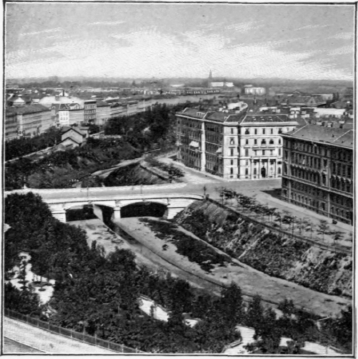
The Wien.

The Elizabeth Bridge And St. Charles' Church.
Strolling one day beside this river, we saw an illustration of the fact that whatever the Germans attempt to do, they usually do with thoroughness. They wished, for example, in this instance, to commemorate a certain name, and we in consequence perceived before us " Schwarzenberg Street" and " Schwarzenberg Bridge," " Schwarzenberg Palace," also, in the distance, " Schwarzenberg Park" beyond it, and, in the foreground of them all, the equestrian statue of Schwarzenberg himself. "Who, then, is this Schwarzen-berg ?" we naturally inquired, as, led by the continual repetition of his name, we drew still nearer to the figure of this mounted warrior. But as soon as we read the inscription on the pedestal, we recollected, of course, that Schwarzenberg was the general who, in 1814, led the Austrian army in the allied host that finally crushed Napoleon.
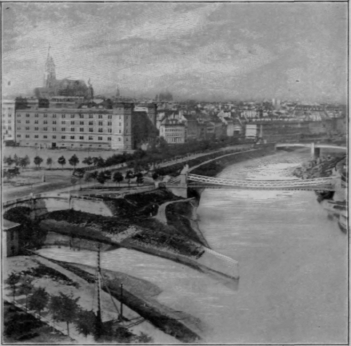
The Junction Of The Wien And The Canal.
Alas for poor humanity! The leveling of Vienna's fortifications, and their transformation into pleasure-grounds and stately promenades, have not been equivalent to the beating of swords into plowshares, nor has the capital's embellishment inaugurated a millennium of peace. The defeats which Austria experienced at the hands of Prussia at Koniggratz and Sadowa, in 1867, have not lessened, but increased, the military spirit of the nation, and Vienna's line of fortifications has merely been expanded into a larger circle. In fact, some of the most conspicuous buildings in and near the city are barracks; and the Imperial Arsenal of Vienna is one of the largest structures in the world. This building is visible at a great distance, and looks like a section of a walled city, -since it is more than a third of a mile in length and a quarter of a mile in breadth. Within this vast enclosure are barracks, gun factories, a cannon foundry, and a military museum. The latter is especially interesting from the number of personal it contains of Austrian warriors, such as Wallenstein's written orders to General Pappenheim, found soaked in blood on his lifeless body after the battle of Lutzen; the hat of Marshal Aldringen, pierced by bullets; the hat of General Heister, which was pinned to his head by an arrow at the siege of Vienna, in 1683 ; the sword of Napoleon's old antagonist, General Wurmser; the uniform and a lock of hair of the brave Prince Eugene, together with many memorials of Joseph II., Marshal Schwarz-enberg, and the Archduke Charles.
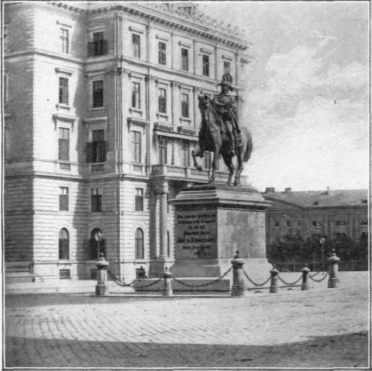
The Statue Of Schwarzenberg.
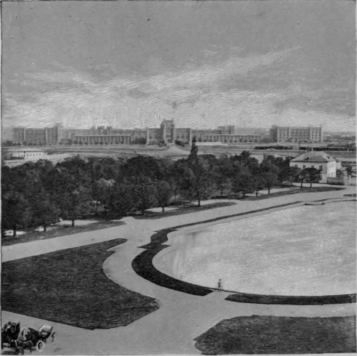
The Arsenal.

The Entrance To The Arsenal.
Strangely enough, in the midst of all these souvenirs of bloodshed and workshops for the enginery of war, there stands a little church, dedicated to the worship of the Prince of Peace! That the world is not yet ready to admit the practicability of Christ's noble precepts of universal brotherhood and non-resistance, is proved by the fact that the leading Christian nations are, to-day, armed to the teeth, grievously burdened with enormous standing armies and expensive navies, and actively engaged in appropriating to themselves the semi-civilized portions of the earth, on the absolutely anti-Christian theory that Might makes Right; while the first and most conspicuous result of having brought Japan into close contact with Christendom has been to transform her into one of the strongest naval powers in the world. The incongruity of building a church within this Arsenal is as great as that of inscribing on Prussian shells the legend, " Gott mit uns." Yet, there can be no doubt that the teaching of Jesus represents the ideal condition which His professed disciples should endeavor to realize, instead of diametrically opposing it; and the words of the poet are still true, if not convincing, when he sings :
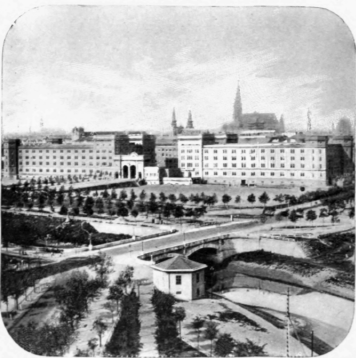
The Franz Joseph Barracks.
Continue to:


